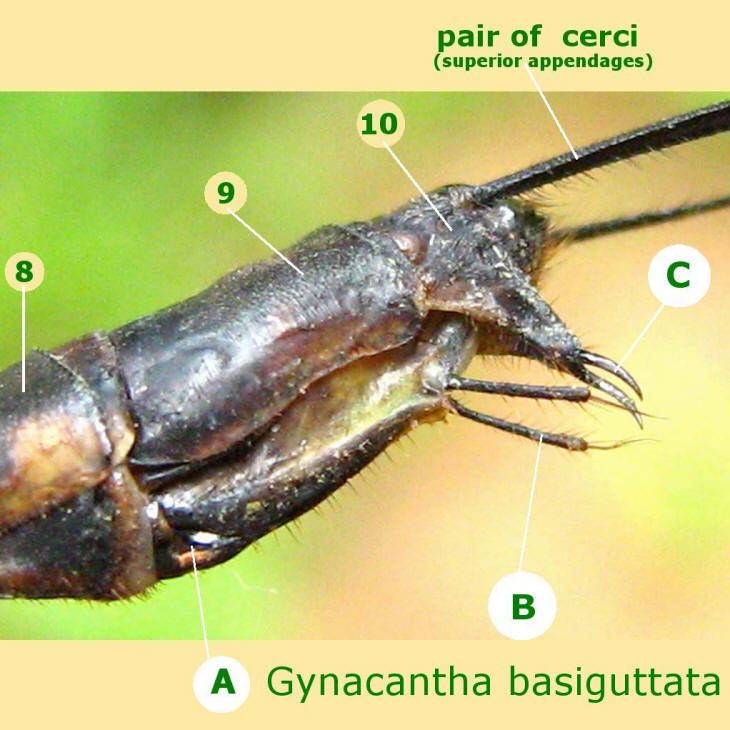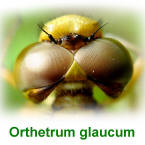
Gynacantha basiguttata
綠眼晏蜓
Found in Asia: Bangladesh, China, Indonesia, Myanmar, Malaysia, Philippines, Peninsular Malaysia, Thailand
Last Updated on Wednesday, 20 September, 2023 09:22:11 PM
INDEX > Dragonflies of Borneo > Family Aeshnidae > Genus Gynacantha > Gynacantha basiguttata 綠眼晏蜓

Gynacantha basiguttata
綠眼晏蜓
Found in Asia: Bangladesh, China, Indonesia, Myanmar,
Malaysia, Philippines, Peninsular Malaysia, Thailand
Gynacantha basiguttata (Selys, 1882) 綠眼晏蜓 is widespread species in Asia.
Comparison between a Male and Female Gynacantha basiguttata
| MALE | FEMALE |
 |
 |
 |
 |
 |
 |
 |
 |
 |
 |
 |
 |
 Male Body length 74mm including superior appendage |
 Female body length 81mm including superior appendage |
 Wing span = 102mm |
 Wing span = 108mmą |


Gynacantha basiguttata is a common species. It is larger than dohrni and the
male superior appendage is expanded into a distinct spatulate shape with a
concentrated tuft of hairs at its tip. The inferior appendage is almost half as
long as the superiors.
It is also called Spoon-tailed Duskhawker because of the spoon like appendages of both male and female.
Gynacantha basiguttata is a large dragonfly species that is easy to recognize.
The wings are clear with a deep brown patch at the base. Eyes are big and greenish. The thorax is generally green and legs are black. The most distinguishing feature is its two spoon-shaped anal appendages. These superior appendages are covered with an inner tuft of hairs.
One of Gynacantha basiguttata characteristics between Male and Female can be observed from the wing base.

Without seeing the abdomen one can tell the sexing by observing the hind
wings: females have a rounded hind wing base, while males have a 90 degrees
angle in their hind wing base.
Abdomen of both male and female are transverse greenish flecks. Male abdomen is slimer.
♂Square angle
♀Rounded

This is a natural-dead spacemen of female Gynacantha basiguttata (Selys, 1882)
who flew into my house in the evening attracted by light and found dead the next
morning.
Gynacantha basiguttata is common in forested swamps. Flies at dawn and dusk.
Hangs from low vegetation by day. Easily attracted to light.
I read about eggs of this dragonfly family in
www.tombon.com.
"The female of Aeshnidae lays eggs in the plant organization (endo-phytic oviposition)or the inside of the mud (sitting-oviposition into mud or mosses)"
This explain why this female's segment 9 and 10 are muddy with even a mud ball
stuck on the pair of claw in segment 10.

Identification Guide to ♂♀Gynacantha basiguttata
a common species of Borneo Island
Male ♂74mm
Body length = 74mm
Wing span = 102mm
Hind wing = 50mm
Female ♀71mmą not including 10mm superior appendage
Body length = 71mmą
appendage = 10mmą
Wing span = 108mmą
Hind wing = 52mmą
A pair of AURICLES (rounded ear-like)
Ref: Page 72 of DRAGONFLIES OF PENINSULAR MALAYSIA AND SINGAPORE by A.G. Orr
More
about MALE Gynacantha basiguttata
More about FEMALE
Gynacantha basiguttata

Ovipositor of a female dragonfly Gynacantha basiguttata
♀76mm
Ovipositor of a female Gynacantha basiguttata containing :
A) A spike like basal plate that serves as cutting blade (at rear end of segment
8)
B) A pair of thin needle like stylus at the end of Valves serving as sensor in
egg positioning (at rear end of segment 9)
C) A pair of sharp anal claws that perhaps serves as anchor to stabilize the
abdomen while the basal plate is cutting hole and inserting eggs into plant.
(segment 10)
Cerci (Anal appendage)

The family of Aeshnidae has a fully formed ovipositor which is a complicated
structure covering segments 8 to 10. The ovipositor is used to insert eggs into
plant tissue, mud, or other substrate.
When the male curls his abdomen down and forward to grasp the female, the cerci
curl under the upper rim of the head (in typical dragonflies) or contact the
mesostigmalplates (in damselflies). Male cerci are often relatively large
appendages with hooks or spines for grasping.
The cerci (the pair of superior appendages) of females are typically simple,
cone-shaped or leaf like structures and only occasionally of use in field
identification.
Stylus of the odonate endophytic ovipositor: a mechanosensory organ
controlling egg positioning

Size of a matured female Gynacantha basiguttata (Selys, 1882)
Wing span = 108mm
Body length = 71mm
Hind wing = 52mm
Female has longer wingspan then male by 10mm
The 3 families of dragonflies found in Borneo Island:
1 Family of Aeshnidae
RELATED TOPICS

INTRODUCTION TO THE DAMSELFLIES OF SABAH, BORNEO ISLAND
Insects are diverse and dominant inhabitants of the tropical rainforests in Borneo Island. New species are discovered too often. Entomologists are still struggling to cope with the documentation of tropical insect diversity.
Most of the common dragonflies in Sabah are red coloured, especially from the family Libellulidae. Some red pecies are even confused as same species, for example the three species of Genus Neurothemis.


The compound eyes of dragonflies
Dragonflies and damselflies have large compound eyes that can see in all directions. When the compound eye is magnified several hundred times, each individual facet (ommatidium) is shown to be hexagonal in shape.

Ovipositor (Vulvar Lamina)
of Female Dragonflies and Damselflies
Female dragonflies have either one of the two method of depositing eggs from
the abdomen:
1- using Ovipositor Structure
2- using Vulvar Lamina
Male do not have an ovipositor. Instead male dragonfly and damselfly have appendages.
|
GO FURTHER FLORA Borneo has 150 species of wild fig trees. Most of them are found in forests of Sabah. FISHERIES Prawn farming is a main commercial activities in Tawau. Spawners from Tawau are graded the best in Malaysia. For decades, Tawau has been exporting high-grade tiger prawns to several countries such as Korea, Japan, Taiwan, China, Vietnam, Singapore, Egypt and Australia. |
|
|
Damselflies of Borneo |